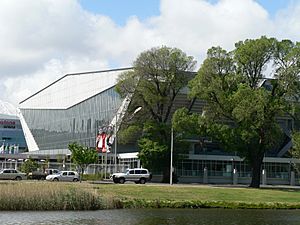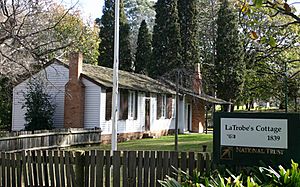John and Phyllis Murphy facts for kids
John and Phyllis Murphy were amazing architects in Australia. They designed many buildings and also helped save old ones. Phyllis was also very good at designing and fixing wallpaper!
The Murphys worked on many projects to save old buildings with the National Trust in the 1960s and 1970s. But their most famous designs were made in the 1950s. One great example is the 1956 Olympic pool in Melbourne, their home city.
John Murphy passed away in 2004.
Their Working Life
John Murphy was born in 1920. Phyllis (whose maiden name was Slater) was born in 1924. She was one of only two women to finish architecture school at the University of Melbourne in 1949!
After they both finished their architecture studies, John and Phyllis started their own design business. This was in 1949, a year before they got married in 1950.
After they helped design the famous 1956 Olympic pool with friends Kevin Borland, Peter McIntyre, and engineer Bill Irwin, their business grew. They started designing homes, then bigger buildings like schools and offices.
Phyllis Murphy wrote about their early work. She said they started their business when it was hard to find building materials, workers, and money. But even with these challenges, people were hopeful and strong after the war.
Their house designs were inspired by a trip to Sweden. There, they saw homes with small living spaces but a simple, fresh, and elegant style.
Their houses, like those designed by Kevin Borland, were known for being lively and creative. They used different structures, colors, and materials. These homes showed how people made big architectural statements even with limited money and space. Architect and friend Neil Clerehan said their houses were simple but also elegant and timeless.
In the 1960s, John and Phyllis became very involved in saving historic buildings. They were founding members and honorary architects for the National Trust of Australia. Phyllis Murphy explained that this work, which might seem boring now, was exciting and new back in the 1950s. It was a fresh way to approach building preservation in Melbourne.
Their commercial projects included buildings for Fintona Girls' School and Caulfield Grammar School. They also designed a television station in Shepparton. They often worked with other architects on projects. They continued their private home designs and restoration work in the 1960s and 70s. This included Emu Bottom Homestead and the front of the Block Arcade on Collins Street.
The Murphys also helped start the Collins Street Defence Movement in the mid-1970s. This group tried to stop old buildings from being torn down on Melbourne's main street. Sadly, their efforts didn't succeed.
John and Phyllis worked together until they retired in 1982.
Important Projects
Just three years after starting their business, in 1952, John and Phyllis, along with Peter McIntyre and Kevin Borland, won a competition to design the Melbourne Olympic Pool. This building is considered one of Australia's best modern designs. The pool was built for the swimming and diving events at the 1956 Melbourne Olympics.
- Bacchus Manor (restoration)
This impressive building was built by Captain Henry Bacchus near Bacchus Marsh, Victoria, around 1838–1840. By 1956, it looked like it should be torn down. A local politician, Vance Dickie, helped save it. The long process of restoring the manor began in 1959.
- La Trobe's Cottage (moved and restored)
This timber cottage was built in 1839 for Charles La Trobe, who was the first superintendent of the Port Phillip District. The Murphys helped move the cottage to its current spot and restore it between 1961 and 1963.
- Emu Bottom Homestead (restoration)
This stone farmhouse and its buildings near Sunbury were built in 1836 for a settler named George Evans. The Murphys guided the restoration of these historic buildings in the late 1960s and early 1970s.
- Collingwood Town Hall (restoration)
The Collingwood Town Hall, built in 1885-90, was in bad shape by 1975. The Collingwood Council started a project to restore the outside of the building. John and Phyllis Murphy were the main experts for this restoration. One big challenge was making sure the repaired parts matched the old parts perfectly. Their excellent work earned the Town Hall an award for outstanding building renovation after it was finished.
Awards and Recognition
- VASS prize, 1944 (Phyllis Murphy)
- Light in Architecture Competition, third prize, 1947 (John and Phyllis Murphy)
- Olympic Swimming Pool (Melbourne) Competition 1952 joint winners.
- RAIA Victorian Chapter Award (John and Phyllis Murphy)
- Merit Award for Outstanding Building Restoration, Collingwood Town Hall (John and Phyllis Murphy, in association with Peter Lovell), 1982
- RAIA Life Fellow, 2009 (Phyllis Murphy)
- Conferred as Doctor of Architecture, honoris causa, University of Melbourne, 2014 (Phyllis Murphy)
- Member of the Order of Australia, 2022 (Phyllis Murphy)



